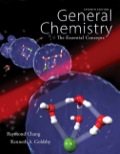
Concept explainers
(a)
Interpretation:
The pH for the given solutions has to be calculated
Concept Information:
Strong base and weak base:
Strong base dissociates into its constituent ions fully. It produces more of hydroxide ions while dissolved in water. Weak bases partially dissociates into its constituent ions.
According to Bronsted-Lowry, strong base is a good proton acceptor whereas weak base is a poor proton acceptor
Since, the ionization of a weak base is incomplete; it is treated in the same way as the ionization of a weak acid.
The ionization of a weak base
The equilibrium expression for the ionization of weak base
Where,
The
Relationship between
The relationship between the hydronium ion concentration and the hydroxide ion concentration is given by the equation,
As
To Calculate: The pH of the given solutions
To calculate the pH of 0.10 M
(a)
Answer to Problem 16.55QP
The pH of the given solution (a) is 11.11
Explanation of Solution
Record the given data
A 0.10-M solution of ammonia at
From the concentration and
Calculation of
The equilibrium table for ammonia can be constructed as follows,
| Initial |
| ||
| Change | |||
| Equilibrium | |||
Therefore, the concentration of hydroxide ion is
Calculation of pOH:
The pOH can be calculated as follows,
Calculation of pH
The pH can be calculated using the following formula as follows,
Therefore, the pH of 0.10 M ammonia solution is 11.11
(b)
Interpretation:
The pH for the given solutions has to be calculated
Concept Information:
Strong base and weak base:
Strong base dissociates into its constituent ions fully. It produces more of hydroxide ions while dissolved in water. Weak bases partially dissociates into its constituent ions.
According to Bronsted-Lowry, strong base is a good proton acceptor whereas weak base is a poor proton acceptor
Since, the ionization of a weak base is incomplete; it is treated in the same way as the ionization of a weak acid.
The ionization of a weak base
The equilibrium expression for the ionization of weak base
Where,
The
Relationship between
The relationship between the hydronium ion concentration and the hydroxide ion concentration is given by the equation,
As
To Calculate: The pH of the given solutions
To calculate the pH of 0.050 M pyridine
(b)
Answer to Problem 16.55QP
The pH of the given solution (b) is 8.96
Explanation of Solution
Record the given datas
A 0.050 M pyridine at
From the concentration and
Calculation of
The equilibrium table for ammonia can be constructed as follows,
| Initial |
| ||
| Change | |||
| Equilibrium | |||
Therefore, the concentration of hydroxide ion is
Calculation of pOH:
The pOH can be calculated as follows,
Calculation of pH
The pH can be calculated using the following formula as follows,
Therefore, the pH of 0.050 M pyridine solution is 10.48
Want to see more full solutions like this?
Chapter 16 Solutions
EBK GENERAL CHEMISTRY: THE ESSENTIAL CO
- Draw the mechanism for the formation of diol by starting with one pen and all in... basic conditions then acidic conditions then draw the mechanism for the formation of a carboxylic acid from your product.arrow_forwardDraw the mechanism for the oxidation of 3-bromo-cyclohexan-1-ol.arrow_forwardConvert the following Fischer projection to Haworth projections. show work and show the arrows please.arrow_forward
- Draw the mechanism for the substitution reaction converting an alcohol into an alkyl halide. If chirality is important to the reaction include it.arrow_forwardWrite, in words three different reactions we can use to make an alcohol.arrow_forwardDraw the reduction mechanism for the reduction of the aldehyde.arrow_forward
 ChemistryChemistryISBN:9781305957404Author:Steven S. Zumdahl, Susan A. Zumdahl, Donald J. DeCostePublisher:Cengage Learning
ChemistryChemistryISBN:9781305957404Author:Steven S. Zumdahl, Susan A. Zumdahl, Donald J. DeCostePublisher:Cengage Learning ChemistryChemistryISBN:9781259911156Author:Raymond Chang Dr., Jason Overby ProfessorPublisher:McGraw-Hill Education
ChemistryChemistryISBN:9781259911156Author:Raymond Chang Dr., Jason Overby ProfessorPublisher:McGraw-Hill Education Principles of Instrumental AnalysisChemistryISBN:9781305577213Author:Douglas A. Skoog, F. James Holler, Stanley R. CrouchPublisher:Cengage Learning
Principles of Instrumental AnalysisChemistryISBN:9781305577213Author:Douglas A. Skoog, F. James Holler, Stanley R. CrouchPublisher:Cengage Learning Organic ChemistryChemistryISBN:9780078021558Author:Janice Gorzynski Smith Dr.Publisher:McGraw-Hill Education
Organic ChemistryChemistryISBN:9780078021558Author:Janice Gorzynski Smith Dr.Publisher:McGraw-Hill Education Chemistry: Principles and ReactionsChemistryISBN:9781305079373Author:William L. Masterton, Cecile N. HurleyPublisher:Cengage Learning
Chemistry: Principles and ReactionsChemistryISBN:9781305079373Author:William L. Masterton, Cecile N. HurleyPublisher:Cengage Learning Elementary Principles of Chemical Processes, Bind...ChemistryISBN:9781118431221Author:Richard M. Felder, Ronald W. Rousseau, Lisa G. BullardPublisher:WILEY
Elementary Principles of Chemical Processes, Bind...ChemistryISBN:9781118431221Author:Richard M. Felder, Ronald W. Rousseau, Lisa G. BullardPublisher:WILEY





